What do museums of contemporary art stand for today? The last two decades has seen an unimaginable diversification of the museum as a place for exhibiting art and telling histories, producing innovative education models, promoting international collaborations, forming alternative archives, and facilitating new productions.
This conference aims to tackle key questions around the museum as an institutional entity and contemporary art as an art historical category. Speakers will provide an overview of developments across the Americas, Europe, Asia, Africa, and the Middle East. With particular attention paid to the construction of historical narratives (or their abandonment) through collection displays, the role of research in relation to contemporary art, the alternative models that are already having an impact, and their relationship to more traditional museum infrastructures.
Presented by the Ph.D. Program in Art History at the CUNY Graduate Center, Independent Curators International, and the New Museum.
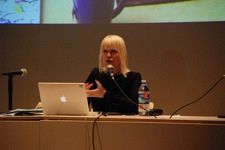


Left to right: Maria Lind; Dara Birnbaum and Ute Meta Bauer; Claire Bishop, Terry Smith, Okwui Enwezor, and Massimiliano Gioni; Eungie Joo and Gabriel Pérez-Barreiro.
Highlights from the Now Museum: Thursday March 10
SCHEDULE
Thursday, March 10 | 7–9 p.m. | New Museum
7:00 p.m. Welcome
by Lisa Phillips, Toby Devan Lewis Director of the New Museum
7:15 p.m. “Exhibition Machines”
A conversation with artist Paul Chan and Philippe Vergne, Director, Dia Art Foundation, New York.
As we face a moment of exhibition and curatorial inflation, are exhibitions, their space and their time, the ultimate venue or language to represent what artists do? How can an institution provide artists with what they need? Can we experience art and representation beyond exhibitions?
Click here to listen to "Paul Chan and Philippe Vergne, Exhibition Machines" from ICI's Art on Air series.
SCHEDULE
Friday, March 11 | 10 a.m.–6 p.m. | CUNY Graduate Center
10:00 a.m. Welcome Watch video
by Claire Bishop, Associate Professor of Art History, at the CUNY Graduate Center
10:15 a.m. “Revisiting The Late Capitalist Museum”
In 1990, Rosalind Krauss published her seminal essay on museums of contemporary art, arguing that the increased scale of museum architecture led the viewer’s attention to focus on a sublime experience of space itself, rather than to the works of art displayed within it. To what extent have Krauss’s arguments been fulfilled in the last twenty years? And have compelling alternatives to her diagnosis arisen in its wake.
A panel discussion with Bruce Altshuler, Director, Program in Museum Studies, New York University (watch video); Manuel Borja-Villel, Director, Museo Nacional Reina Sofia, Madrid (watch video); and Beatriz Colomina, Professor, Department of Architecture, Princeton University (watch video).
Chaired by Johanna Burton, Director, Bard Center for Curatorial Studies.

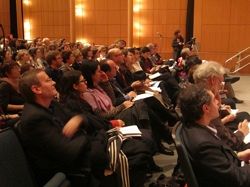

Beatriz Colomina; Manuel Borja-Villel; Bruce Altshuler; and Johanna Burton; the crowd at the CUNY Graduate Center, March 11, 2011.
SCHEDULE
12:00 p.m. “Sources of the Contemporary Museum”? Watch video
When did the sources of curatorial activity that we con- sider to be “contemporary” emerge, and where? How do these precursors relate to the subsequent demands of the globalized contemporary art museum? How does globalization become internalized in both works of art and museum practices?
A conversation with Carlos Basualdo, Curator of Contemporary Art at the Philadelphia Museum of Art, and Curator at MAXXI, Rome, and Pamela M. Lee, Professor, Department of Art and Art History, Stanford University.

Pamela M. Lee and Carlos Basualdo.
SCHEDULE
2:30 p.m. “The Artist’s Perspective” Watch video
A conversation with artist Dara Birnbaum and Ute Meta Bauer, Associate Professor and Director, Program in Art, Culture, and Technology, MIT.
With the exponential growth of contemporary art museums, what new demands are being placed upon artists? Have women artists benefited from this proliferation? Given that time-based media has been present in the museum for over forty years, how have these works changed museums, and the way audiences use them?

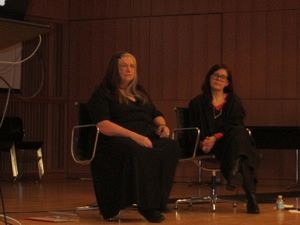

Dara Birnbaum and Ute Meta Bauer; Queens Museum director Tom Finkelpearl asks a question.
SCHEDULE
3:40 p.m. “Contemporanizing History/Historicizing the Contemporary” Watch video
Recent attempts to define contemporary art (and contemporaneity) as an era distinct from the modern and the postmodern have all revolved around the question of our relationship to history. How do we periodize the contemporary? Does the distinction between modern and contemporary art hold up in a global context? How has a changed relationship to history, and an awareness of art’s new geographies, been made apparent in recent museum practice?
A panel discussion with Okwui Enwezor, Director, Haus der Kunst, Munich (watch video); Annie Fletcher, Curator, Van Abbe Museum, Eindhoven (watch video); Massimiliano Gioni, Associate Director and Director of Exhibitions, New Museum (watch video); and Terry Smith, Professor of Contemporary Art History and Theory, University of Pittsburgh (watch video).
Chaired by Claire Bishop, Associate Professor of Art History, CUNY Graduate Center. Watch video



Terry Smith and Okwui Enwezor; Annie Fletcher; Massimiliano Gioni.
SCHEDULE
Saturday, March 12 | 12–6 p.m. | New Museum
12:00 p.m. Welcome
by Eungie Joo, Director and Curator of Education and Public Programs at the New Museum, and Kate Fowle, Director of Independent Curators International Watch video
12:15 p.m. “Extending Infrastructures, Part I: Platforms & Networks” Watch video
The last decade has seen the evolution of institutions that enable the development of networks and collaborations between artists, curators, and organizations both regionally and internationally. These platforms have generated programming and research that goes beyond national or localized mandates of the traditional contemporary art museum, and instead encourages the accumulation of knowledge through shared concerns based on experience and practice. This has led to new ways of thinking about collecting, recording histories, and producing discourse, as well as extending exhibition models and the involvement of artists in the creation of institutional structures. What are the key issues and practices that have generated these new frameworks?
A panel discussion with Zdenka Badovinac, Director, Moderna Galerija, Ljubljana (watch video); Anthony Huberman, Distinguished Lecturer, Hunter College and Director, The Artist’s Institute, New York (watch video); Maria Lind, Director, Tensta Konsthall, Stockholm; and Lu Jie, Director and Chief Curator, Long March Project, Beijing (watch video).
Chaired by Kate Fowle, Director, Independent Curators International, New York.



Maria Lind, Anthony Huberman, and Kate Fowle; Zdenka Badovinac, Lu Jie and Claire Bishop; Maria Lind and Anthony Huberman.
SCHEDULE
2:30 p.m. “Extending Infrastructures, Part II: Bricks & Mortar” Watch video
Following up on the day’s earlier panel, how are the tangible, physical manifestations necessary for the development of contemporary art infrastructures conceptualized for a specific region, emphasis, or audience? What is necessary to participate meaningfully in international and local contexts? Panelists will discuss the development of contemporary art infrastructures today including the birth of new museums, the relevance of the model, the future of patronage, and challenges.
A panel discussion with Richard Armstrong (watch video), Director, Solomon R. Guggenheim Foundation (watch video); curator and artist Gabi Ngcobo, Johannesburg (watch video); and Gabriel Pérez-Barreiro, Director, Colección Patricia Phelps de Cisneros, New York and Caracas. Chaired by Eungie Joo, Director and Curator of Education and Public Programs, New Museum (watch video).
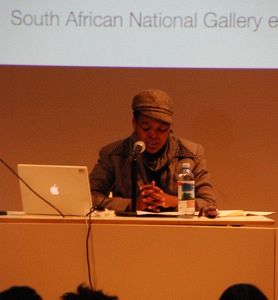
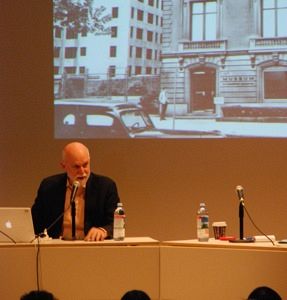

Gabi Ngcobo; Richard Armstrong; an audience member asks a question.
SCHEDULE
4:45 p.m. “What does the museum stand for now?” Watch video
Responses by Katy Siegel, Professor, Department of Art, Hunter College and Dominic Willsdon, Curator of Education and Public Programs, San Francisco Museum of Modern Art.

Dominic Willsdon and Katy Siegel.
SCHEDULE
Sunday, March 13 | 2–6 p.m. | New Museum
2:00 p.m. “Graduate Students Respond”
A graduate student symposium co-chaired by Claire Bishop, Kate Fowle, and Martin Grossmann, Professor, School of Art and Communications, University of São Paulo.
Panel 1: “Museums and Collections”
Kari Cwynar, Banff Center: “The Museum as a Contact Zone: New Ways of Seeing Art at the Art Gallery of Ontario” (watch video); Alice Heeren, School of the Art Institute of Chicago: “The Inhotim Institute: Articulating Local and Global in Display Strategies in Brazil” (watch video); Saisha Grayson, CUNY Graduate Center: “What Makes a Museum Contemporary? The Van Abbe and MACBA Rethink the Permanent Collection” (watch video).

Saisha Grayson, Alice Heeren, Kari Cwynar, and Kate Fowle.
Kari Cwynar is an emerging curator and art historian based in Banff, Canada. She recently completed her MA in Art History at Carleton University and holds a BAH in Art History from Queen’s University. Cwynar’s graduate research focuses on contemporary curatorial strategies in museum collections, specifically examining the case study of the Art Gallery of Ontario’s 2008 rehang and expansion. She is currently completing a Curatorial Research Work Study at The Banff Centre.
Alice Heeren is a MA candidate in the Art History, Theory and Criticism department at the School of the Art Institute of Chicago. Born in Belo Horizonte, Brazil, she is finishing her thesis entitled The Inhotim Institute: A Museum in Constant Transformation. She holds BFA in Printmaking and a BA in Art Education from the Universidade Federal de Minas Gerais. Currently, her focus is in contemporary art institutions and museum architecture in Brazil.
Saisha Grayson received an MA in Contemporary Art & Curatorial Studies from Columbia University and is currently a PhD student at the Graduate Center, CUNY where she focuses on contemporary art, feminist theory and museum practices, with a dash of medieval and film studies thrown in. She also does freelance curating around New York, and, in her pre-graduate school years, worked as a communications and PR consultant to museums and arts institutions throughout the United States. Her recent article, “Disruptive Disguises: The Problem of Transvestite Saints for Medieval Art, Identity, and Identification,” appeared in Medieval Feminist Forum’s Winter 2009 issue.
SCHEDULE
Panel 2: “Artists and Museums” Watch video
Jessica Gogan, University of Pittsburgh: “Hélio Oiticica’s Experimental and Constructive Legacy for Contemporary Museums” (watch video); Michelle Jubin, CUNY Graduate Center: “Artist-Educators and Education-as-art in New York” (watch video); Natalie Musteata, CUNY Graduate Center: “Collection as Medium: Why do museums invite artists to re-hang collections?” (watch video).

Natalie Musteata, Michelle Jubin, Jessica Gogan, and Martin Grossmann.
Jessica Gogan is a Ph.D. student in Art History at the University of Pittsburgh and an independent curator and educator working in USA and Brazil. In 2010 she curated an exhibition by Brazilian artist José Rufino at The Andy Warhol Museum and co-coordinated educational initiatives for the exhibition “Hélio Oiticica: Museum is the World and the Museum of Modern Art in Rio de Janeiro.” Her article “Museum as Artist: Creative, Dialogic and Civic Practice” published by Animating Democracy/Americans for the Arts, reflects on aspects of her former work as Director of Education at The Andy Warhol Museum.
Michelle Jubin is a doctoral student in Art History at the CUNY Graduate Center, NY. Hailing from Glasgow, UK, she worked as a contributor for BBC Radio Scotland and as an artist’s assistant for the sculptor Andy Goldsworthy before first coming to New York to work at the Solomon R. Guggenheim Museum, New York and, later, Independent Curators International (ICI). She is currently a Graduate Teaching Fellow in Art History at Baruch College. Michelle is a recent contributor to West 86th, the Bard Graduate Center for Decorative Arts and Design journal, and Slashstroke, a London-based art and fashion magazine.
Natalie Musteata is a Ph.D. student in Art History at The Graduate Center, CUNY, and an adjunct lecturer at Kingsborough College. She earned a B.A. with Highest Honors from The University of California, Berkeley. In 2008 she collaborated with Jens Hoffmann on “The Wizard of Oz”, an exhibition at the CCA Wattis Institute. From 2009-2010 she worked as Curatorial Fellow and Research Assistant at Performa. Her essay, “Wired to History: Romanian and Lithuanian Video Art Post 1989” was published on the Former West website. More recently, she participated in “To Act or Not to Act: Ethics in Romanian Cinema”, a conference at the University of Pittsburgh.







